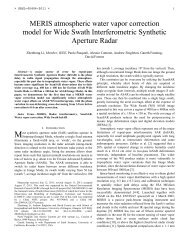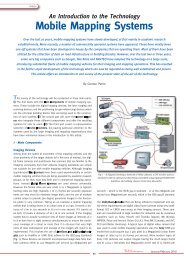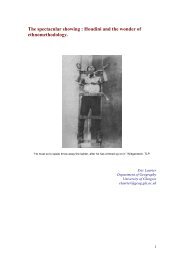Café Ethnography : the uses of tables and chairs
Café Ethnography : the uses of tables and chairs
Café Ethnography : the uses of tables and chairs
Create successful ePaper yourself
Turn your PDF publications into a flip-book with our unique Google optimized e-Paper software.
Selecting a table<br />
<strong>Café</strong> <strong>Ethnography</strong>:<br />
Fig. 1 Instruction to <strong>the</strong> user <strong>of</strong> an informal setting: 'When <strong>the</strong> shop is busy- please<br />
queue for food before taking a seat that way everyone is happy. -Thankyou'<br />
Many <strong>of</strong> <strong>the</strong> most exclusive restaurants in Europe require <strong>the</strong> booking <strong>of</strong> a table<br />
months in advance, indeed in some cases up to a year in advance. Some may not even<br />
allow a table to be booked unless <strong>the</strong> customer is already in some way known to <strong>the</strong>m.<br />
Merely booking a table is a first step in <strong>the</strong> production <strong>of</strong> formality in <strong>the</strong>se kinds <strong>of</strong><br />
socially exclusive restaurants (Finkelstein 1989). At <strong>the</strong> Flaming Cup <strong>Café</strong> <strong>the</strong>re is a<br />
sign on <strong>the</strong> door (see Fig.1) requesting that during busy periods customers do not<br />
attempt to reserve a seat before <strong>the</strong>y have queued up at <strong>the</strong> counter to order <strong>the</strong>ir food.<br />
The sign is hard to miss, written as it is on a lilac-coloured A4 sheet <strong>of</strong> paper, secured<br />
with blue-tack at <strong>the</strong> average height <strong>of</strong>f <strong>the</strong> ground where most customers will find its<br />
instruction directly in front <strong>of</strong> <strong>the</strong>ir gaze. It is also situated above a small pink sign<br />
which contains a warning about a ramp surface which customers might miss <strong>the</strong>ir<br />
footing on. After you become a regular at <strong>the</strong> Flaming Cup <strong>Café</strong> <strong>the</strong>n you know <strong>the</strong><br />
rule <strong>and</strong> <strong>the</strong> warning <strong>and</strong> tend to stop reading <strong>the</strong> sign.<br />
For <strong>the</strong> staff this DIY pink sign was an ever vigilant yet friendly (it is, after all,<br />
h<strong>and</strong>written, polite in tone <strong>and</strong> pink) doorkeeper (Latour 1992). It is a doorkeeper in<br />
<strong>the</strong> sense that it is passing on an instruction to those who enter <strong>the</strong> café, reminding<br />
customers to behave in a manner that suites <strong>the</strong> staff's need for maximum turnover <strong>of</strong><br />
9
















